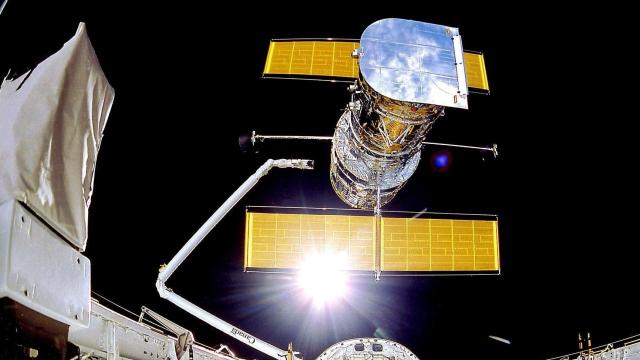A glitching 1980s-era computer is causing headaches for a NASA operations team struggling to bring the Hubble Space Telescope back online.
The problem started on June 13, when Hubble’s payload computer, which controls and coordinates the orbiting spacecraft’s science instruments, stopped working. Hubble’s main computer took action by putting all science instruments into safe mode, and it’s been that way ever since. To date, all attempts to restart the truck-sized telescope have failed.
“The Hubble operations team is working to solve the payload computer issue onboard the Hubble Space Telescope,” explained a NASA spokesperson in an emailed statement. “The team is working to collect all the data available to them to isolate the problem and determine the best path forward for bringing the computer back to operations.”
To which the spokesperson added: “At this time, there is no definitive timeline for bringing the computer back online.”
Launched in 1990, the $US2.5 ($3) billion space telescope has impacted virtually every field in astronomy, but Hubble is starting to show its age. The faulty payload computer is a substitute for the original, having been replaced during a Space Shuttle mission in 2009. That said, the replacement computer is equipped with original components that date back to the 1980s.
A degrading memory module was initially blamed for the anomaly, but as NASA explained this Tuesday, a “different piece of computer hardware may have caused the problem, with the memory errors being only a symptom.” NASA is now targeting the Standard Interface (STINT) hardware as a possible source of the trouble. STINT provides a communications link to the payload computer’s Central Processing Module (CPM) and other devices. But, as NASA admitted, the problem might also have to do with the CPM itself. The operations team is now attempting to validate these possibilities and devise potential remedies.
Should the issue continue, the team might switch to the STINT and CPM hardware on the backup payload computer. If this happens, “several days will be required to assess the computer performance and restore normal science operations,” according to NASA. The switching on of the backup computer could be a precarious moment, as the device hasn’t been switched on since its installation in 2009.
This is truly a vexing problem to solve. In addition to dealing with legacy components, the operations team is having to “service” a satellite located 350 miles (560 kilometers) above Earth’s surface. With the Space Shuttle program retired, NASA has no choice but to devise a solution from the ground.
On a positive note, Hubble’s telescope remains in operation, as NPR reports. Scientific instruments like the Advanced Camera for Surveys and the Cosmic Origins Spectrograph are currently in safe mode, but Hubble’s 2.4-metre telescope continues to gaze into the cosmos, which it does following a predetermined schedule. Paul Hertz, the director of astrophysics for NASA, said the “reason we do that is so that the telescope keeps changing its orientation relative to the sun in the way that we had planned, and that maintains the thermal stability of the telescope, keeps it at the right temperature,” as he told NPR.
Hubble is a survivor, and it has consistently overcome technical issues in the past, the most recent being a software problem experienced in March of this year. It may be ageing, but the telescope is expected to last well into the 2030s. We’re now holding our breath to see if NASA can make this happen.
